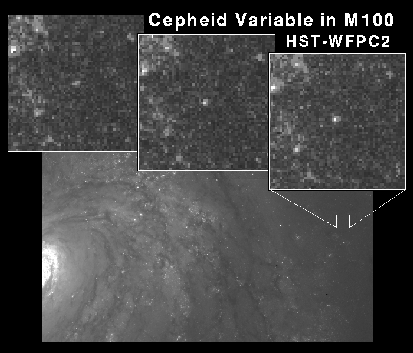Explanation: Can this blinking star tell us how fast the universe is expanding? Many astronomers also believe it may also tell us the age of the universe! The photographed "Cepheid variable" star in M100 brightens and dims over the course of days as its atmosphere expands and contracts. A longer blinking cycle means an intrinsically brighter star. Cepheids variable stars are therefore used as distance indicators. By noting exactly how long the blinking period is and exactly how bright the star appears to be, one can tell the distance to the star and hence the star's parent galaxy. This distance can then be used to match-up easily measured recessional velocity ("redshift") with distance. Once this "Hubble relation" is determined for M100, it should be the same for all galaxies - and hence tell us how fast the universe is expanding. The exact magnitude of this calibration is under dispute and so a real live debate involving the value of Hubble's constant titled "The Scale of the Universe" will occur in April 1996 in Washington, DC.
1999 2000 2001 2002 2003 2004 2005 2006 2007 2008 2009 2010 2011 2012 2013 2014 2015 2016 2017 2018 2019 2020 2021 2022 2023 2024 2025 |
Yanvar' Fevral' Mart Aprel' Mai Iyun' Iyul' Avgust Sentyabr' Oktyabr' Noyabr' Dekabr' |
NASA Web Site Statements, Warnings, and Disclaimers
NASA Official: Jay Norris. Specific rights apply.
A service of: LHEA at NASA / GSFC
& Michigan Tech. U.
|
Publikacii s klyuchevymi slovami:
M 100 - Cefeidy - Postoyannaya Habbla - Rasshirenie Vselennoi
Publikacii so slovami: M 100 - Cefeidy - Postoyannaya Habbla - Rasshirenie Vselennoi | |
Sm. takzhe:
Vse publikacii na tu zhe temu >> | |
